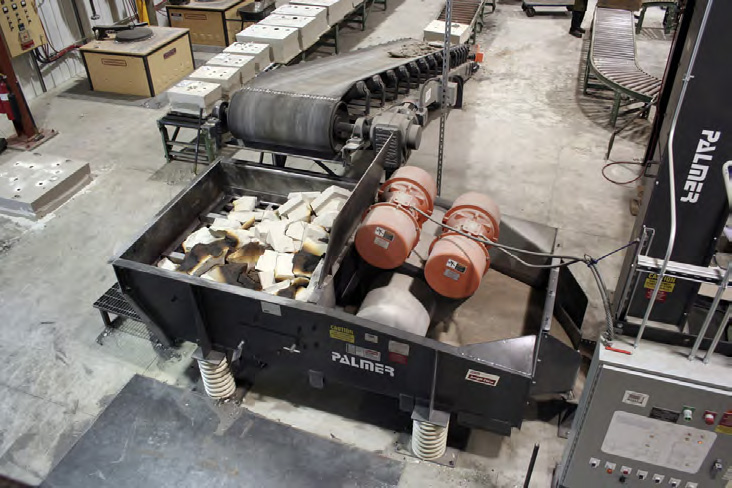Foundry & industrial processing Machinery EQUIPMENT & SYSTEMS
U.S. & Canada Call 1.800.457.5456
Advances in Sand Reclamation
Home Articles Advances in Sand Reclamation

Foundry Management & Technology Magazine, February, 2021 issue.
Written - Jack Palmer.
Reprinted by permission of Penton Media, Inc.
Now is the time to be look at newer sand reclamation technologies, to reduce cost and environmental impacts, and to enhance casting quality.

Most everyone realizes that sand reclamation is necessary for cost reducing and environmental requirements. While the popularity of sand reclamation certainly resulted from increasing sand prices (caused primarily by the demand for fracking), there are few processes that provide as many immediate benefits as sand reclamation.
Automatic strike-off machines also are available and easily added to most systems. Rollover draw machines, the workhorse of any molding system, can be configured for 100% automatic function.
Staffing for all molding systems is roughly the same (depending upon size), but typically there will be one mixer operator, one utility operator to help strike-off and set sleeves and rods, and a third operator to help with pattern changes and bringing consumables to the mold and prep areas. Obviously, there will be more labor needed for coating, coring, closing, and clamping functions, but those are outside the scope of this discussion.
The following popular molding systems can be categorized as those systems with and without a rollover.
Square-loop molding system - The most popular system for producing chemically bonded sand molds worldwide are variants of what is commonly called a "square loop" or "fast loop.""
Operation: Operator fills, compacts, and strikes off on a compaction table. Once the mold is struck off it is moved using varying designs of power roller conveyor, power belts, powers transfer cars, and a rollover that separates the sand mold from the tooling. The mold exits the rollover and is followed by the tooling. The mold moves away from the loop for the subsequent loose piece removal, coating, and drying (if ferrous), placing the cores or core packages in the drag, closing the cope over the drag, and clamping. Then, the mold is ready to be poured. Tooling is either returned to the loop or removed and replaced with the next job.
Advantages: Regarding material handling, this type of loop has been proven hundreds of times around the world. It can easily be custom configured to the available floor space, to the types of work being made, and any special needs like chill setting, ram-up cores, or reinforcing rods. Changes to this design are fairly straightforward – if the type of work changes, or the rate of production needs to increase, different machine types can be added or removed.
Disadvantages: Compared to other designs, more floor space is required and the complete system is comparatively expensive. Maintenance costs will be high because there will be dozens of proximity switches, motors, gearboxes, chains, and sprockets. Rollovers are inherently complex, with hydraulic valves and cylinders, motors, switches, and beam devices (for proof of position, proof of draw), pneumatic valves, power cords, and hydraulic hoses and lines. Wheels and track on the transfer cars will require maintenance, as will the festooning that brings power to the transfer cars, on-board power roller conveyor, and the drive to move the car on the track. The control system, while not overly complex, is often custom-designed, adding to the cost and complexity.
In general, the maximum production rate maxes out at 15 molds per hour because the cycle time of the rollover (box-in to box-in) is usually about two minutes.
Carousel rollover molding system - This is the second most popular molding design. Generally, a carousel will have three to four jobs on board with six or eight boxes.
Operation: An empty box is pulled off the carousel onto the compaction table; filled, compacted and struck off; and returned to the carousel, which is then indexed one station. The fill station is positioned at 180° from the rollover station, so that a full box moves into the rollover, the mold is drawn, and it moves outboard of the rollover. An empty box is returned to the carousel.
Advantages: The main one is the simplicity and low cost compared to the square loop. The complete system has a single drive mechanism to index, which eliminates the dozens of gearboxes, chains, sprockets, proximity switches, etc. Programming is simplified too, as the carousel is the lone moving part in the system.
Capital costs are much lower, for obvious reasons. A proper design has gravity rollers on board to eliminate the complexity of powering a conveyor on a rotating mechanism. A simple pusher moves the full box into the rollover and the power roller conveyor on the rollover pushes the empty box back onto the carousel.
Disadvantages: The perceived disadvantages are the fixed number of stations / time to change patterns, or perform the necessary prep functions with rods, sleeves, etc. With proper system design, pattern changes can be accomplished easily “in cycle,” meaning the normal amount of time it takes to fill, compact, and strike-off a box, which, in general, is two minutes.
Since the mount board on every job is the same, there is no need for accurate positioning of the box on the station, regardless of size, which makes the pattern change simple and efficient.
Unless changing tooling, there are three stations to perform any necessary prep work, allowing for six minutes to blow out the box and place insulating sleeves, any reinforcing rods and ram-up cores, and chills. If proper material handling methods are followed, all prep materials will be ready and correct for every job as soon as the carousel stops moving. In the case of a high number of chills (as in complex aerospace castings, it might require more than six minutes. But, if a "kit" is prepared in advance for each job, even dozens of chills can be placed in cycle.
The rollover will have the same capital costs and maintenance requirements as the conveyor-based system, and the production rate also will be a maximum of 15 molds per hour. Space requirements are generally less than the conveyor based system.
Copyright © 2024 Palmer Manufacturing & Supply, Inc. | Terms and Conditions | Privacy Policy
Web published by Marketing Options, LLC.




